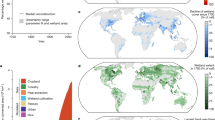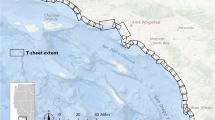Abstract
Wetland resources have continued to decline in coastal regions of the United States despite passage of the 1972 Clean Water Act, creation of federal and state wetland permitting programs, and declaration of the goal of “no net loss” of wetland resources. Wetland loss rates were assessed across 20 counties in coastal North Carolina from 1994 to 2001 using 1994 wetland inventory data from the North Carolina Division of Coastal Management (NCDCM) and the 2001 National Land Cover Dataset. Accuracy assessment results were used to generate adjusted estimates of wetland loss, and the results were compared to restoration data from the NCDCM. Total wetland loss from 1994 to 2001 was 25,303 ha, or 1.95% of the 1994 wetland area. Of the total, 17,858 ha converted to upland and 7,445 ha converted to open water. These results are somewhat higher than published loss rates for Atlantic coastal watersheds and for the United States as a whole. By contrast, agency records suggest that a maximum of 4,591 ha of wetland restoration and 68 ha of wetland creation were begun in the 20 North Carolina coastal counties from 1994 to 2001.




Similar content being viewed by others
References
Beyer HL (2004) Hawth’s analysis tools for ArcGIS. Available via www.spatialecology.com/htools. Accessed 12/7/2010
Brady S, Flather C (1994) Changes in wetlands on nonfederal rural land of the conterminous United States from 1982 to 1987. Environmental Management 18:693–705
Brinson MM (1989) Fringe wetlands in Albemarle and Pamlico Sounds: landscape position, fringe swamp structure, and response to rising sea level. Albemarle-Pamlico Estuarine Study Report 88-14
Cashin G, Dorney J, Richardson C (1992) Wetland alteration trends on the North Carolina coastal plain. Wetlands 12:63–71
Congalton RG (1991) A review of assessing the accuracy of classifications of remotely sensed data. Remote Sensing of Environment 37:35–46
Congalton RG, Green K (1993) A practical look at the sources of confusion in error matrix generation. Photogrammetric Engineering and Remote Sensing 59:641–644
Crossett KM, Culliton TJ, Wiley PC, Goodspeed TR (2004) Population trends along the coastal United States: 1980–2008.Coastal Trends Report Series. National Oceanic and Atmospheric Administration. Silver Springs, MD, USA
Dahl TE (2000) Status and trends of wetlands in the conterminous United States: 1986 to 1997. U.S. Fish and Wildlife Service, Washington, DC
Dahl TE (2006) Status and trends of wetlands in the conterminous United States: 1998 to 2004. U.S. Fish and Wildlife Service, Washington, DC
Dahl TE, Johnson CE (1991) Wetlands status and trends in the conterminous United States: mid-1970’s to mid-1980s. U.S. Fish and Wildlife Service, Washington, DC
Dahl TE, Dick J, Swords J, Wilen BO (2009) Data collection requirements and procedures for mapping wetland, deepwater, and related habitats of the United States. US Fish and Wildlife Service, Madison
Day JW Jr, Butler TJ, Conner WG (1977) Productivity and nutrient export studies in a cypress swamp and lake ecosystem in Louisiana. In: Wiley M (ed) Estuarine Processes. Academic, New York, pp 255–269
Farber SC (1987) The value of coastal wetlands for protection of property against hurricane damage. Journal of Environmental Economics and Management 14:143–151
Hay AM (1988) The derivation of global estimates from a confusion matrix. International Journal of Remote Sensing 9:1395–1398
Hefner JM, Brown JD (1985) Wetland trends in the southeastern United States. Wetlands 4:1–11
Hefner JM, Moorhead KK (1991) Mapping pocosins and associated wetlands in North Carolina. Wetlands 11:377–389
Hefner JM, Wilson BO, Dahl TE, Frayer WE (1994) Southeast wetlands: status and trends, mid-1970’s to mid-1980’s. U.S. Fish and Wildlife Service, Atlanta
Homer C, Huang C, Yang L, Wylie B, Coan M (2004) Development of a 2001 National Land-Cover Database for the United States. Photogrammetric Engineering and Remote Sensing 70:829–840
Homer C, Dewitz J, Fry J, Coan M, Hossain N, Larson C, Herold N, McKerrow A, VanDriel JN, Wickham J (2007) Completion of the 2001 National Land Cover Database for the conterminous United States. Photogrammetric Engineering and Remote Sensing 73:337–341
Hopkinson CS Jr (1985) Shallow-water benthic and pelagic metabolism: evidence of heterotrophy in the nearshore Georgia. Marine Biology 87:19–32
Hord RM, Brooner W (1976) Land-use map accuracy criteria. Photogrammetric Engineering and Remote Sensing 42:671–677
Johnston CA, Detenbeck NE, Niemi GJ (1990) The cumulative effect of wetlands on stream water quality and quantity: a landscape approach. Biogeochemistry 10:105–141
Kelly NM (2001) Changes in landscape pattern of coastal North Carolina wetlands under the Clean Water Act, 1984-1992. Landscape Ecology 16:3–16
Knutson PL, Ford JC, Inskeep MR (1981) National survey of planted salt marshes (vegetative stabilization and wave stress). Wetlands 1:129–157
Knutson PL, Brochu RA, Seelig WN, Inskeep MR (1982) Wave damping in Spartina alterniflora marshes. Wetlands 2:87–104
Mallin MA, Ensign SH, McIver MR, Shank GC, Fowler PK (2001) Demographic, landscape, and meteorological factors controlling the microbial pollution of coastal waters. Hydrobiologia 460:185–193
Moorhead K, Brinson M (1995) Response of wetlands to rising sea level in the lower coastal plain of North Carolina. Ecological Applications 5:261–271
Moorhead K, Cook A (1992) A Comparison of hydric soils, wetlands, and land-use in coastal North Carolina. Wetlands 12:99–105
National Agriculture Imagery Program 2004 NAIP Digital Orthophotography. U.S. Farm Service Agency,,. Available via http://www.apfo.usda.gov. Accessed 6/18/2010
National Agriculture Imagery Program 2006 NAIP Digital Orthophotography. U.S. Farm Services Agency,,. Available via http://www.apfo.usda.gov. Accessed 6/18/2010
Nixon SW (1980) Between coastal marshes and coastal waters—A review of twenty years of speculation and research on the role of salt marshes in estuarine productivity and water chemistry. In: Hamilton P, MacDonald KB (eds) Estuarine and wetland processes. Plenum, New York, pp 437–525
North Carolina Office of State Budget and Management (2001) April 2000 County Census Populations, with Growth and Migration from April 1990. Available via http://www.osbm.state.nc.us/ncosbm/facts_and_figures/socioeconomic_data/population_estimates/demog/cens00gr.html. Accessed 12/11/2010
Poulter B (2005) Interactions between landscape disturbance and gradual environmental change: plant community migration in response to fire and sea level rise. PhD dissertation, Duke University
Poulter B, Feldman RL, Brinson MM, Horton BP, Orbach MK, Pearsall SH, Reyes E, Riggs SR, Whitehead JC (2009) Sea-level rise research and dialogue in North Carolina: creatings windows for policy change. Ocean and Coastal Management 52:147–153
Riggs SR, Ames DV (2003) Drowning the North Carolina coast: sea-level rise and estuarine dynamics. NC Sea Grant, Raleigh
Rosenfield GH, Fitzpatrick-Lins K, Ling HS (1982) Sampling for thematic map accuracy testing. Photogrammetric Engineering and Remote Sensing 48:131–137
Shull LN III (1999) An Accuracy Assessment of GIS Wetland Mapping in the Coastal Counties of North Carolina. NC Division of Coastal Management, Raleigh, NC, USA
Stedman SM, Dahl TE (2008) Status and trends of wetlands in the coastal watersheds of the eastern United States: 1998 to 2004. National Marine Fisheries Service and U.S. Fish and Wildlife Service, Washington, DC
Stehman SV (1997) Selecting and interpreting measures of thematic classification accuracy. Remote Sensing of Environment 62:77–89
Stockton M, Richardson C (1987) Wetland development trends in coastal North Carolina, USA, from 1970 to 1984. Environmental Management 11:649–657
Story M, Congalton RG (1986) Accuracy assessment: a user’s perspective. Photogrammetric Engineering and Remote Sensing 52:397–399
Sutter L (1999) DCM wetland mapping in Coastal North Carolina. N.C. Division of Coastal Management, Raleigh
Tiner RW (1984) Wetlands of the United States: current status and recent trends. U.S. Fish and Wildlife Service, Washington, DC
U.S. Fish and Wildlife Service (1995) Photointerpretation conventions for the National Wetlands Inventory. St. Petersburg, FL, USA
Weller CM, Watzin MC, Wang D (1996) Role of wetlands in reducing phosphorus loading to surface water in eight watersheds in the Lake Champlain Basin. Environmental Management 20:731–739
Whigham DF, Chitterling C, Palmer B (1988) Impacts of freshwater wetlands on water quality: a landscape perspective. Environmental Management 12:663–671
Wilen BO, Bates MK (1995) The US Fish and Wildlife Service’s National Wetlands Inventory Project. Vegetatio 118:153–169
Yang L, Stehman SV, Smith JH, Wickham J (2001) Thematic accuracy of MRLC land cover for the eastern United States. Remote Sensing of Environment 76:418–422
Acknowledgments
Funding for this project was provided by the National Ocean and Atmospheric Administration under CZM Strategic Planning Grant # NA17OZ2345 to the North Carolina Division of Coastal Management. I thank staff at the NC Ecosystem Enhancement Program, NC Department of Transportation, and NC Division of Water Quality for assistance in calibrating the NCDCM mitigation site database with other statewide databases. I am also grateful to Dr. Kenneth Rose (LSU), the associate editor, and two anonymous reviewers for helpful comments on earlier drafts of this manuscript.
Author information
Authors and Affiliations
Corresponding author
Electronic supplementary material
Below is the link to the electronic supplementary material.
Figure S1
Overlay of wetland conversion data and 2006 NAIP aerial photography (PDF 272 kb)
Figure S2
Wetland losses between 1994 and 2001 (PDF 223 kb)
Figure S3
Wetland loss in New Hanover County, NC between 1994 and 2001 (PDF 187 kb)
Figure S4
Wetland conversion to open water near Wrightsville Beach, NC (PDF 197 kb)
Table S1
Decision rules used to assign wetland change classes (PDF 20 kb)
Table S2
Comparison to U.S. Fish and Wildlife Service Status and Trends Reports (PDF 20 kb)
Rights and permissions
About this article
Cite this article
Carle, M.V. Estimating Wetland Losses and Gains in Coastal North Carolina: 1994–2001. Wetlands 31, 1275–1285 (2011). https://doi.org/10.1007/s13157-011-0242-z
Received:
Accepted:
Published:
Issue Date:
DOI: https://doi.org/10.1007/s13157-011-0242-z




